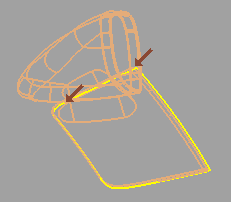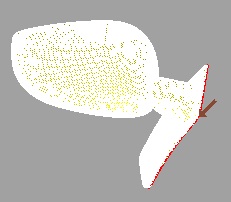Export Rapid Prototype
Creates valid output for rapid prototyping, which includes manifold, watertight meshes with consistent normals in .STL or .ZPR file formats.
Export Rapid Prototype Control options
File Format
The format of the output file, STL or ZPR (Windows only).
Format
The format of the output STL file (ASCII or Binary). The default setting is Binary.
Stitch Tolerance
Controls how accurately surfaces are tessellated.
Max Edge Length
Specifies the maximum length of any triangle edge (in current linear units).
Flip Normals
Flips the mesh normal and the mesh display orientation
Create Wall Thickness
Makes the mesh solid by thickening the walls according the the Wall Thickness setting.
Wall Thickness
Specifies the thickness of the mesh walls.
Display Color
For ZPR format, displays stitch color assignments on the mesh in flat shaded mode.
Export Rapid Prototyping workflows
Manifold, watertight meshes with consistent normals are required for successful rapid prototyping. Using this workflow, you can create valid output from a surface, a shell, a mesh, or any combination of these. This workflow helps you stitch surfaces, tessellate shells, evaluate meshes for errors, and then repair the meshes, if necessary, before exporting to the .stl file format.
Create and export valid output from surfaces
Choose File > Export > Rapid Prototype
 .
. The Export Rapid Prototype Control dialog box opens.
Select the surfaces.
Click the Accept button to create a shell.
The surfaces are stitched. The prompt line indicates how many shells were created and the number of unmatched boundaries found, if any.

Open boundaries are highlighted and small arrows point to problem areas on the model.

If the shell is a closed volume (0 boundaries), proceed to step #5.
Note: Multiple shells may indicate a problem with the topology of the surfaces for rapid prototyping. Unstitch the shell, fix the surfaces and start the procedure again.
To close any open boundaries, adjust the Stitch Tolerance value and click Update.
Stitch Tolerance determines which boundaries will be stitched together when you update. If two boundaries are further apart than this value at some point, they are not stitched there.
If the shell still has open boundaries, re-adjust the Stitch Tolerance value and click Update. Repeat until you cannot reduce the number of open boundaries any further.
When the shell has few or no open boundaries, click Accept.
The options change in the Export Rapid Prototype Control dialog box to include Tolerance, Max Edge Length, Flip Normals, and Create Wall Thickness options.
Click the Create Mesh button to convert the shell into a mesh.
The shell is tessellated based on the settings in the dialog box. The prompt line indicates how many meshes were created, the number of polygons, and the number of boundaries found.

The tessellated model displays with normal orientation shading in flat shaded mode. Normal orientation is set automatically based on external visible parts of the model being in the positive direction. Open boundaries are highlighted and small arrows point to problem areas on the model.

Adjust the following settings and click Update.
Tolerance – Controls how accurately surfaces are tessellated. The lower the value, the greater the number of triangles. This value will be reflected in the resolution of the physical model that will be produced by the rapid prototyping technology.
Max Edge Length – Specifies the maximum length of any triangle edge (in current linear units).
The shell is retessellated based on the set values.
To flip the mesh normals and the mesh display orientation, check Flip Normals.
To make the mesh solid, check Create Wall Thickness and adjust the Wall Thickness value, and then click Update.
The mesh offset updates. Repeat until you have a solid mesh.
When you are satisfied with the model, select the Format of the file, either ASCII or Binary.
To display stitch color assignments on the mesh in flat shaded mode, click Display Color.
Click Export to save the file in the selected format. The Export Rapid Prototype dialog box opens.
Enter a name for the file in the Object name field and click Save.
Create and export valid output from a shell
File > Export > Rapid Prototype
 .
. The Export Rapid Prototype Control dialog box opens.
Select the shell object.
Click the Create Mesh button to convert the shell into a mesh.
The shell is tessellated based on the settings in the dialog box. The prompt line indicates how many meshes were created, the number of polygons, and the number of boundaries found.

The tessellated model displays with normal orientation shading in flat shaded mode. Normal orientation is set automatically based on external visible parts of the model being in the positive direction. Open boundaries are highlighted and small arrows point to problem areas on the model.

Adjust the following settings and click Update.
Tolerance – Controls how accurately surfaces are tessellated. The lower the value, the greater the number of triangles. This value will be reflected in the resolution of the physical model that will be produced by the rapid prototyping technology.
Max Edge Length – Specifies the maximum length of any triangle edge (in current linear units).
The shell is retessellated based on the set values.
To flip the mesh normals and the mesh display orientation, check Flip Normals.
To make the mesh solid, check Create Wall Thickness and adjust the Wall Thickness value and click Update.
The mesh offset updates. Repeat until you have a solid mesh.
When you are satisfied with the model, select the Format of the file, either ASCII or Binary.
To display stitch color assignments on the mesh in flat shaded mode, click Display Color.
Click Export to save the file in the selected format. The Export Rapid Prototype dialog box opens.
Enter a name for the file in the Object name field and click Save.
Create and export valid output from a mesh
Choose File > Export > Rapid Prototype
 .
. The Export Rapid Prototype Control dialog box opens.
Select the mesh object.
Click the Accept button.
The prompt line indicates the number of meshes, polygons, and boundaries found. Small arrows point to open boundaries on the model so you can quickly identify problem areas.
To flip the mesh normals and the mesh display orientation, check Flip Normals.
To make the mesh solid, check Create Wall Thickness and adjust the Wall Thickness value, and then click Update.
The mesh offset updates. Repeat until you have a solid mesh.
When you are satisfied with the model, select the Format of the file, either ASCII or Binary.
Click Export to save the file in the selected format. The Export Rapid Prototype dialog box opens.
Enter a name for the file in the Object name field and click Save.
